People with cast-iron skillets often ask questions like can you season cast-iron with olive oil or how often to season cast-iron? People also want to know what is the best oil to season cast-iron as well as season cast-iron on the stove. Well, we are going to talk about all of these things today, and more so you can take better care of your dependable cast-iron skillets.
Why season your cast-iron skillet?
Cast-iron skillets can last a lifetime if taken care of properly, and you must reseason your cookware whenever you start seeing rusting on any part of it. Cast-iron skillets have a nonstick layer called the patina that is necessary for it to be used daily.
This patina is removed by the frequent application of water and soap, which is why it is not recommended that you use dish soap on it. At most, you should only be cleaning your cast-iron skillet with boiling water and Kosher salt, coupled with an abrasive scrubbing pad or stiff-bristled brush.
Unfortunately, a ball of steel wool is not a recommended cleaning implement for any cast-iron cookware because it can cause severe damage to the lining of cast-iron cookware. However, stiff-bristled brushes, the ones made of plastic, can remove debris from the pans without damaging the surface.
Seasoning should be done at least once a month, especially if the cookware is in constant use. It is not hard work, anyone can do it, and the results are going to be excellent each time. Take some time to learn how to reseason your pans properly, and they will serve you in the kitchen for a lifetime.
Season Cast-Iron on Stove
If you do not have access to an oven, you can try to reseason your cast-iron skillet on the stove, and here are the steps to accomplish that:
- First of all, this method of seasoning cast-iron skillets can be very smoky, so make sure that you crack open a window because we are going to push the envelope on the oil that you are going to be using. You can use any neutral vegetable oil for seasoning a skillet.
- Place your skillet on the stove and get it to the level where it is absurdly hot, and it is smoking everywhere. Make sure you protect your hands – grab the pan and apply the vegetable oil to all sides (inside and out). Two-three tablespoons of vegetable oil are plenty. Use paper towels to apply the oil. Don’t rush it as this may cause an accident, but don’t take too long that the pan becomes too cold.
- After applying the oil, turn up the heat again to about a medium for 10 to 15 minutes. Take note that this process transforms neutral vegetable oil to other components that produce the desired patina on the skillet. The patina is the smooth, nonstick finish that makes iron skillets so desirable as cookware.
- During the seasoning process, you should see a lot of smoke coming from your pan. The oil will eventually dry out, and this is to be expected. As we have mentioned before, you should make sure that the windows are open to let out all the smoke. Some people don’t like this method obviously because of the smoke, but it does get the job done well even without an oven.
The Conventional Method of Seasoning Skillets
Baking a skillet is the more traditional method, and it eliminates most of the smoke associated with directly heating a pan on the stovetop.
- You can use the following oils for reseasoning: canola oil, avocado oil, sunflower oil, safflower oil, coconut oil, peanut oil, sesame oil, and olive oil.
- Just this once, wash your skillet with hot water and dish soap. We know that this isn’t usually done, but you are going to season your skillet anyway, so it’s okay.
Focus on removing any burnt food that may have stuck to the sides, walls, and bottom of the skillet. Use a stiff-bristled brush or an abrasive scouring pad. Dry the skillet with a clean cloth or with paper towels. - Preheat your oven to 350 degrees Fahrenheit. While your oven is warming up, it’s time to coat your skillet with your choice of oil. You only need a small quantity of vegetable oil to season each pan. Two to three tablespoons are plenty. If you have several pans to reseason, season them in the oven one at a time. Use paper towels or a clean cloth to coat all the sides of your skillet.
- When all of the sides of the skillet have been coated, it’s time to bake and season it. Place your pan at the center of the oven. Place a measure of aluminum foil, or large baking try under the level where you have placed your skillet. The skillet should be placed in the oven upside down, with the bottom facing up. Some of the oil will drip; this is to be expected.
- The seasoning process in the oven is slightly longer than when you season on a stove. The reason for this is that the fire isn’t hitting the surface of the metal directly, so there’s more indirect heat going on. Bake the pan for about an hour.
- When the one hour is up, pull out the skillet and allow a few minutes to allow the metal to cool down. Feel free to add some more oil to its surface before wiping down one last time and storing it. If you did things correctly, you should see a beautiful patina on your skillet again, and no rust anywhere.
- Again, if you cook a lot at home and your skillets are usually battered, reseason them once every month to keep them in excellent condition.

